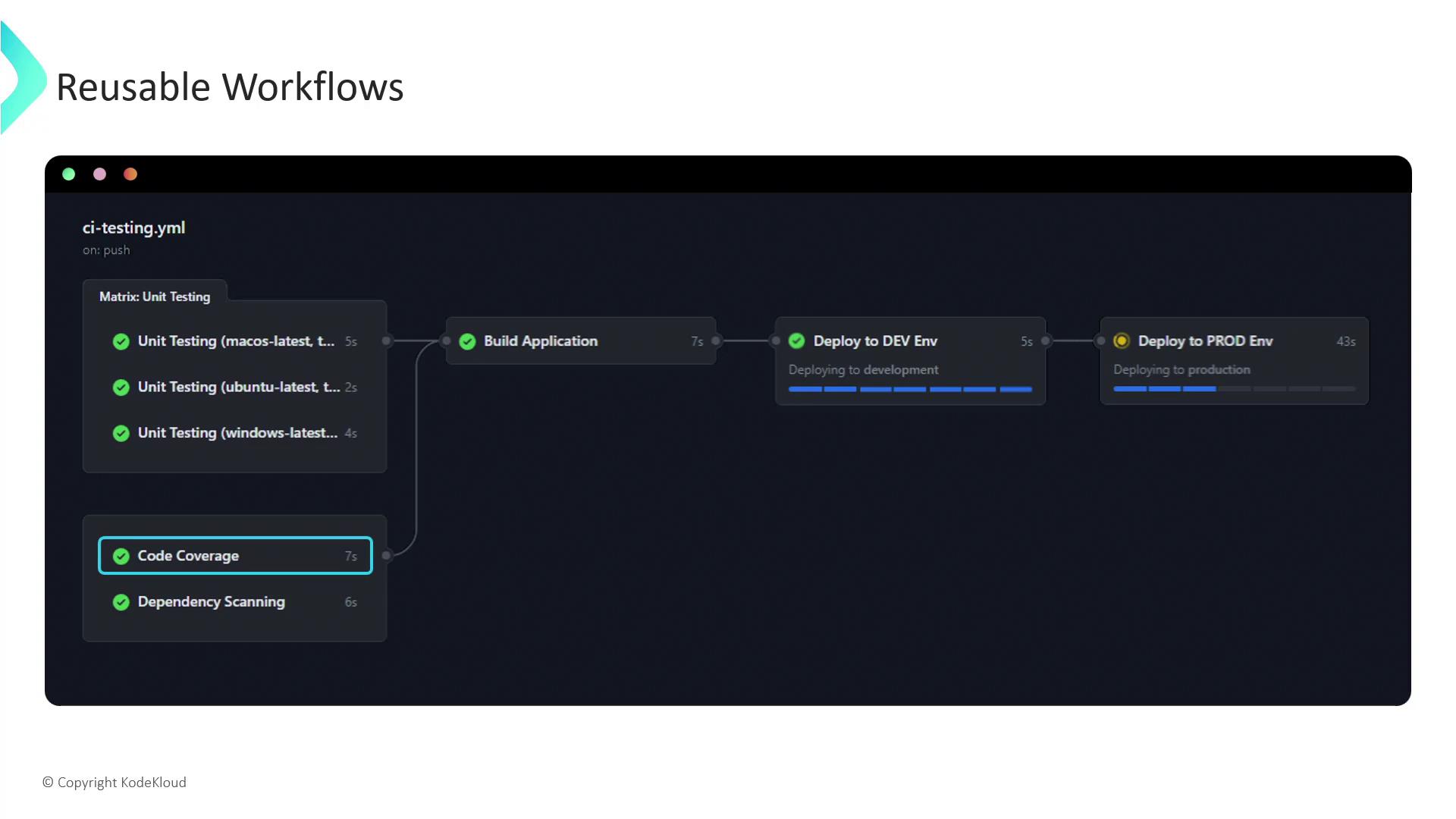GitHub Actions
Reusable Workflows and Reporting
Understanding Reusable Workflows
Creating modular, maintainable CI/CD pipelines is essential for growing codebases. GitHub Actions reusable workflows let you extract common jobs—such as deployments—into standalone workflows that multiple repositories or branches can call. This approach eliminates duplication, reduces errors, and enforces consistent deployment practices across projects.

The diagram above depicts a typical CI/CD pipeline for a Node.js application:
- Unit Testing
- Code Coverage
- Dependency Scanning
- Build
- Deploy to Dev (runs after build succeeds)
- Deploy to Prod (waits for Dev deployment)
Each deployment job consists of five granular steps (e.g., environment setup, artifact upload, feature flag toggles, smoke tests, notifications).
Why Use Reusable Workflows?
Imagine your organization maintains services in Java, Python, .NET, Go, and more. While build and test commands differ, deployment steps—like provisioning infrastructure, uploading artifacts, and running smoke tests—tend to be identical. Reusable workflows centralize these shared steps:
| Programming Language | Build Tool | Test Tool | Deployment Steps |
|---|---|---|---|
| Java | Maven/Gradle | JUnit/TestNG | Provision → Deploy → Smoke Test → Notify |
| Python | pip/Poetry | pytest | Provision → Deploy → Smoke Test → Notify |
| .NET | dotnet build | xUnit | Provision → Deploy → Smoke Test → Notify |
| Go | go build | go test | Provision → Deploy → Smoke Test → Notify |
| Node.js | npm/ Yarn | Jest/Mocha | Provision → Deploy → Smoke Test → Notify |
By extracting deployment logic into its own workflow, you avoid copy-pasting nearly identical YAML across repositories. Instead, each app’s pipeline can call the reusable deployment workflow.
1. Extracting the Deployment Job
Let’s say you have a repository xyz-org/nodejs-app-repo with .github/workflows/awesome-app.yml:
# .github/workflows/awesome-app.yml
name: My Awesome App
on: push
jobs:
unit-testing:
# ... unit test definitions ...
code-coverage:
# ... code coverage definitions ...
build:
# ... build definitions ...
dev-deploy:
needs: build
runs-on: ubuntu-latest
steps:
- name: Step 1
# ...
- name: Step 2
# ...
- name: Step 3
# ...
- name: Step 4
# ...
- name: Step 5
# ...
To DRY-up your CI/CD, move the dev-deploy job into its own reusable workflow file:
# .github/workflows/reusable-dev-deploy.yml
name: Reusable Dev-Deploy Workflow
on:
workflow_call:
jobs:
deploy:
runs-on: ubuntu-latest
steps:
- name: Step 1
# ...
- name: Step 2
# ...
- name: Step 3
# ...
- name: Step 4
# ...
- name: Step 5
# ...
Note
The on: workflow_call trigger makes this workflow callable from other workflows. You can also define inputs, outputs, and secrets under workflow_call for advanced parameterization.
2. Calling a Reusable Workflow
Back in awesome-app.yml, replace the inline dev-deploy job with a reference to the reusable workflow:
# .github/workflows/awesome-app.yml
name: My Awesome App
on: push
jobs:
unit-testing:
# ...
code-coverage:
# ...
build:
# ...
dev-deploy:
needs: build
uses: ./.github/workflows/reusable-dev-deploy.yml
If the reusable workflow lives in another repository, reference it by {owner}/{repo}/{path}@ref:
jobs:
dev-deploy:
needs: build
uses: my-org/common-workflows/.github/workflows/reusable-dev-deploy.yml@main
Warning
When calling workflows in private repositories, ensure the caller has appropriate permissions and that any required secrets: are declared in the called workflow’s workflow_call section.
3. Inputs, Outputs, and Secrets
To make your reusable workflows more flexible:
- Inputs allow callers to pass parameters (e.g., environment name, version tag).
- Outputs let callers consume results (e.g., artifact URLs, deployment IDs).
- Secrets ensure sensitive data—like cloud credentials—are never exposed.
Example of declaring inputs and secrets in a reusable workflow:
# .github/workflows/reusable-dev-deploy.yml
on:
workflow_call:
inputs:
env-name:
description: 'Deployment environment'
required: true
type: string
secrets:
API_TOKEN:
required: true
jobs:
deploy:
runs-on: ubuntu-latest
steps:
- name: Deploy to ${{ inputs.env-name }}
env:
TOKEN: ${{ secrets.API_TOKEN }}
# ...
Benefits of Modular CI/CD with Reusable Workflows
- Consistency: Enforce the same deployment steps across all services.
- Maintainability: Update a single workflow file to propagate changes everywhere.
- Scalability: Easily onboard new projects by referencing prebuilt workflows.
- Security: Centralize and manage secrets in one place.
Links and References
- GitHub Actions: Reusing workflows
- GitHub Actions: Workflow syntax for GitHub Actions
- GitHub Actions: Workflow commands
Watch Video
Watch video content